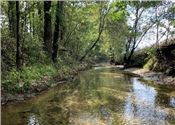Protecting Water Resources On Private Land Helps Its Value

Riparian borders like the vegetation on each side of portions of Catalpa Creek near Starkville, Mississippi, provide many ecological services for small rivers and streams.
Photo by MSU Department of Wildlife, Fisheries, and Aquaculture/Beth Baker
DR. BETH HARLANDER BAKER
STARKVILLE, MISSISSIPPI
The presence of a water source on private land can make a property much more desirable for several reasons. Whether it’s a lake, pond, stream or river, a water source provides opportunities for recreation, development, agricultural production, and wildlife and fisheries habitat.
A key aspect of maintaining the value of the water resource is ensuring that it is protected and used wisely.
Stewardship of private lands’ water resources includes maintaining the quality of the water as well as the quantity. For instance, consider sedimentation; when sediment moves from uplands, that soil can accumulate in the water body.
While erosion is a natural process, land use activities combined with intense rainfall can increase erosion rates. Sedimentation in water bodies reduces the water-holding capacity and degrades aquatic habitat, while also increasing flood risk to adjacent landscapes.
Where surface water bodies are present, make sure adjacent landscapes have appropriate conservation measures to limit sediment and pollutant transport.
One critical conservation measure is maintaining vegetation in a riparian area – or the landscapes directly surrounding water bodies – as the interface between land and water.
Riparian areas provide many ecological services, which is why protection and management of these areas is so important. For example, small streams and rivers are home to diverse aquatic species and terrestrial wildlife that rely on the areas around the water body for shade, cover and water to thrive. These areas also provide corridors between patches of habitat, allowing wildlife to move about the landscape to meet their biological needs.
Maintaining vegetative buffers and corridors around water bodies will stabilize banks, provide flood and erosion control, improve habitat for wildlife, enhance diversity of flora and fauna, and provide shade, among many other ecosystem services. Maintaining riparian areas will also filter and slow runoff carrying sediment and pollutants before they reach the water body.
Common surface-water pollutants include bacteria and nutrients, such as nitrogen and phosphorus used as fertilizer. Excess nutrients from agricultural production can run off landscapes into adjacent water bodies and result in overgrowth of algae and bacteria in downstream waters. When algae die, the decomposition process uses oxygen in the water, resulting in very low oxygen levels that can lead to fish kills. Smart nutrient management considers the right type of fertilizer, right amount, right place and right timing to limit losses of fertilizer from fields.
Bacterial contamination can enter water bodies when sewage lines break, when septic systems are not properly maintained, or when waste from livestock and wildlife is carried into waterbodies with runoff.
Always report odd smells or leakage into a water body and perform regular maintenance of on-site septic systems to prevent fecal contamination of water resources.
In agricultural systems, having a management plan for safe handling of manures and fencing waterways to keep animals out can ensure a healthy water source and protect pastures from erosion.
The protection of water resources requires local knowledge, action and proactive planning to ensure landowners and communities have the natural resources they need for the future. Taking small, sustainable steps on private lands to ensure that water is being used wisely and habitats remain intact will help protect and maintain the water resources on your property.
For more information about conservation, contact Beth Baker with the Research and Education to Advance Conservation and Habitat program at Mississippi State University at 662-325-7491 or beth.baker@msstate.edu ∆
DR. BETH HARLANDER BAKER: MSU Extension Service